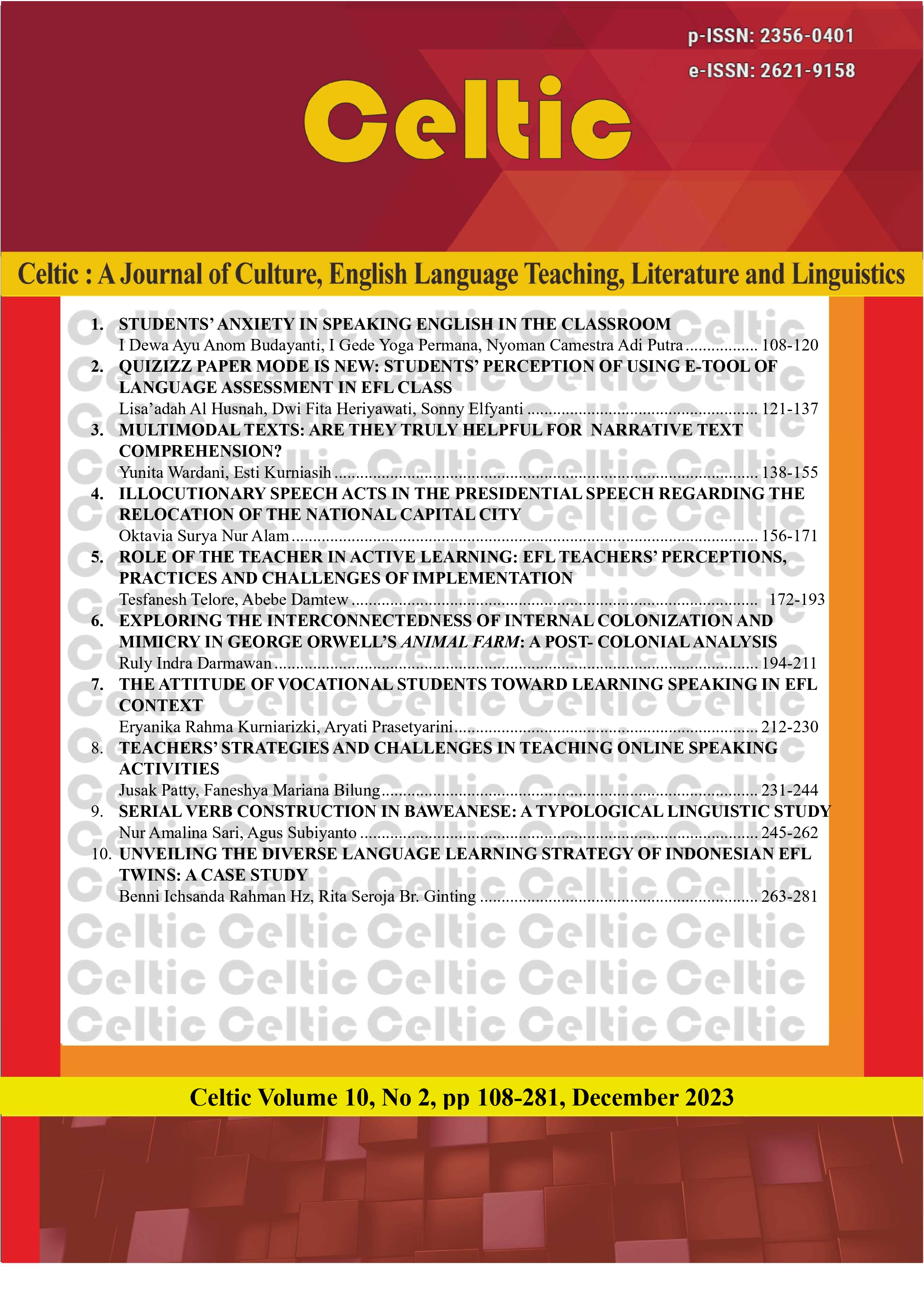EXPLORING THE INTERCONNECTEDNESS OF INTERNAL COLONIZATION AND MIMICRY IN GEORGE ORWELL’S ANIMAL FARM: A POST-COLONIAL ANALYSIS
DOI:
https://doi.org/10.22219/celtic.v10i2.29004Abstract
In Animal Farm, George Orwell introduces mimicry and internal colonisation. Mimicry, a basic notion in human imitation, is used to study Napoleon and his porcine companions. Homi K. Bhabha's ambivalence and “same but not quite” theory examines mimicry. The pigs' behaviour is explained by these post-colonial theories. This study also shows how internal colonisation underlies narrative mimicry. This study claims that the story's copying indicates colonization's lasting effects and is a strategy for internal colonisation. Old Major's clear speech inspires Animal Farm residents to imitate humans, making them feel inadequate. This study reveals how internal or external colonisation divides colonised people. In this approach, people may adopt the conquering entity's cultural norms and values as superior. Another group may be indigenous. Internal colonisation by another party or associated group could result through imitation rivalry. This level requires imitation to demonstrate power. Animal Farm exemplifies colonised people imitating colonisers. This detailed analysis of Animal Farm by George Orwell shows how imitation and internal colonisation are interconnected.
Downloads
References
Bhabha, H. K. (1994) Location of Culture. New York: Routledge.
Byrne, E. (2009) Homi K. Bhabha. New York: Palgrave Macmillan.
Calvert, P. (2021) “Internal Colonization, Development, and Environment.” New York: Third World Quarterly.
Chaloult, N. B, and Yves. (1979) “The Internal Colonialism Concept: Methodological Considerations.” Social and Economic Studies 28.4
Clemons, A. M., & Grieser, J. A. (2023). Black Womanhood. Daedalus, 152(Summer 23), 115–129.
Craven, M. (2012) Colonialism and Domination. Oxford Scholarly Authorities on International Law. London
Darmawan, R. I. (2020). “Revisiting Bhabha’s Mimicry in George Orwell’s Animal Farm. Pioneer: Journal of Language and Literature”, [S.l.], v. 12, n. 2, p. 141-156
De Lange, Ad. (2007) Autobiography: An Analysis of ‘Shooting an Elephant’ in Harold Bloom. Bloom’s Modern Critical Views: George Orwell. New York: Chelsea Huse Publishers.
Gabbert, W. (2020). Human Sacrifice, Ritualised Violence and the Colonial Encounter in the Americas. In R. Antony, S. Carroll, & C. Pennock (Eds.), The Cambridge World History of Violence (The Cambridge World History of Violence, pp. 96-116). Cambridge: Cambridge University Press. doi:10.1017/9781316340592.006
Handika, M., & Hartiningsih, S. (2017). An Analysis of Feminism Idea that represented by Queen Elizabeth I in the Shekhar Kapur’s Film Entitled “Elizabeth: The Golden Age.” In Celtic : A Journal of Culture, English Language Teaching, Literature and Linguistics (Vol. 1, Issue 2, pp. 75–82). https://ejournal.umm.ac.id/index.php/celtic/article/view/4669
Huddart, D. (2006). Homi K. Bhabha. London. Routledge.
Höglund, J., & Burnett, L. A. (2019). Introduction: Nordic Colonialisms and Scandinavian Studies. Scandinavian Studies, 91(1–2), 10–27.
Kohn, M., & Reddy, K. (2023). Colonialism. The Stanford Encyclopedia of Philosophy (Spring 2023 Edition). https://plato.stanford.edu/archives/spr2023/entries/colonialism/
Morrock, R. (1973). “Heritage of Strife: The Effects of Colonialist "Divide and Rule" Strategy upon the Colonized Peoples”. Science & Society Vol. 37, No. 2. New York. Guilford Press. .pp. 129-151
Morse, D. E. (2012). "A Blatancy of Untruth”: George Orwell’s Uses of the Fantastic in Animal Farm.” Hungarian Journal of English and American Studies 1. p. 89
Ortner, S., (1995). “Resistance and the problem of ethnographic refusal”. Comparative Studies in Society and History, 37 (1), 173–193. doi:10.1017/S0010417500019587
Pennycook, A. (2002). English and the Discourse of Colonialism. London: Routledge.
Rae, P. (2009) “Orwell, World War I modernism and the Spanish Civil War”, Journal of War & Culture Studies, 2:3, 245-258, DOI: 10.1386/jwcs.2.3.245/1
Rachmayanti, E., & Andini, T. M. (2014). An analysis of Japanese rituals of a new geisha in Arthur Golden’s novel Memoirs of Geisha. In A Journal of Culture, English Language Teaching, Literature, and Linguistics (Vol. 1, pp. 83–90).
Reynolds, A. R. (2020). Introduction: Colonization, Modernity, and the Editorialization of the Americas. Textual Cultures, 13(2), 1–9. https://doi.org/10.14434/textual.v13i2.31591
Sabol, S. (2017). Assimilation and Identity. In “The Touch of Civilization.” https://doi.org/10.2307/j.ctt1mtz7g6.10
Sabol, S. (2017). Internal Colonization. In “The Touch of Civilization.” https://doi.org/10.2307/j.ctt1mtz7g6.9
Sabol, S. (2017). Through the Colonial Looking-Glass. In “The Touch of Civilization.” https://doi.org/10.2307/j.ctt1mtz7g6.8
Schlumberger, O. (2017). Authoritarian Regimes.1093/oxfordhb/9780199935307.013.18.
Tyson, L. (2020). Critical Theory Today: A User-Friendly Guide. New York: Routledge.
Wagner, F. (2016). Colonial Internationalism: How Cooperation Among Experts Reshaped Colonialism (1830s-1950s).
Waltz, K. (1979). Theory of Internationaolitics, Addison-Wesley, Reading.
Williams, C.W. Mitchell and Stephen Wyn. (1978). “Internal Colonialism.” Area 10.
Yang, G., Qixue Zhang and Qi Wang. (2016) “The Essence, Characteristics, and Limitation of Postcolonialism: From Karl Marx’s Point of View.” Frontiers of Philosophy in China 1.
Ypi, L. (2013). “What is Wrong with Colonialism,” Philosophy and Public Affairs 41, no. 2, 158-191.
Downloads
Published
How to Cite
Issue
Section
License
Copyright (c) 2023 Ruly Indra Darmawan

This work is licensed under a Creative Commons Attribution-ShareAlike 4.0 International License.
- Authors retain copyright to publish without restrictions and grant the journal right of first publication with the work simultaneously licensed under a Creative Commons Attribution License that allows others to share the work with an acknowledgement of the work's authorship and initial publication in this journal.
- Authors are able to enter into separate, additional contractual arrangements for the non-exclusive distribution of the journal's published version of the work (e.g., post it to an institutional repository or publish it in a book), with an acknowledgement of its initial publication in this journal.
- Authors are permitted and encouraged to post their work online (e.g., in institutional repositories or on their website) prior to and during the submission process, as it can lead to productive exchanges, as well as earlier and greater citation of published work.














